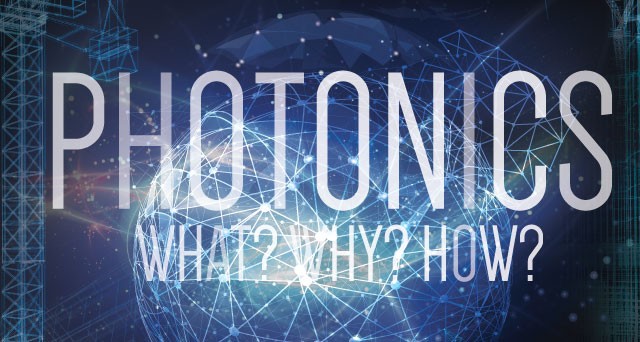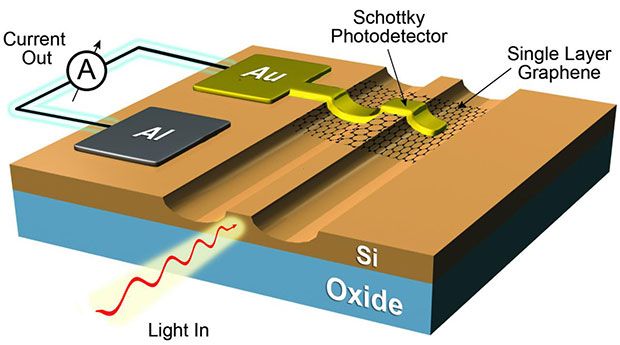- Jun 24, 2016
- 636
Photon;
SOURCE: rochestercitynewspaper.com (ARTICLE DATE: 30th Sep 2015)
What is photonics?
Photonics means slightly different things to different people, so it's best to start in the broadest terms.
Generally speaking, photonics refers to the development of technologies based around the application, manipulation, and use of light. It's basically the same thing as optics, which focuses on the transmission of visible light, such as lasers, and invisible ultraviolet and infrared light. Some scientists and researchers differentiate between the two, often viewing photonics as more of an application-oriented field.
Fiber optic networks are a common example of photonics at work: powerful lights and extremely thin glass cables are used to transmit massive amounts data at very high speeds, often over long distances..

The Department of Defense is keen on integrated photonics, which basically weds ultra-high-tech optical systems with high-tech electronics. It's putting approximately $115 million into the initiative, known as the American Institute for Manufacturing Photonics.
What is the purpose of AIM Photonics?
First and foremost, AIM Photonics is a Department of Defense program.
The DOD sees promise in the technologies, especially for use in infrared imaging, radar, sensors, and something officials refer to as "electronic warfare," which means radar jamming and similar technologies. Many of the institute's innovations will end up in battle gear, including drones...
Focus Shifting To Photonics:
SOURCE: semiengineering.com (ARTICLE DATE: 17th Aug 2016)
Silicon photonics finally appears ready for prime time, after years of unfulfilled expectations and a vision that stretches back at least a couple decades...
The biggest challenge has been the ability to build a light source directly into the silicon process, rather than trying to add one onto a chip after manufacturing. Intel today said it has achieved that milestone, setting the stage for building economies of scale into the process. That may take several more years, but it nonetheless represents an important step for this technology.
Seeing the light
There are a number of advantages to using silicon photonics. For one thing, light pulsing through a waveguide on a chip generates much less heat than electrons moving through copper wire—particularly a very skinny copper wire where resistance, as well as the power necessary to drive those electrons, generate heat. Light is also faster that electrons, less prone to cybersecurity issues, and there are fewer physical effects. Photons do not interact the way electrons do, which allows them to be bunched together much more tightly and to cross paths without affecting signal integrity...
Could Enable the Internet of Things:
SOURCE: spectrum.ieee.org (ARTICLE DATE: 8th Jul 2016)
While silicon-based photodetectors can do the job for detecting visible light, they fall short when it comes to detecting near-infrared radiation (NIR). The reason for this is that the energy of NIR photons at telecom wavelengths is not strong enough to bridge the band gap of silicon. For this reason, photodetectors have been fashioned out of a combination of silicon and germanium, which requires a complex and comparatively expensive fabrication process. This new graphene-silicon combination could be far simpler and cheaper to produce...

“This is a significant result which proves that graphene can compete with the current state of the art by producing devices that can be made more simply, cheaply and work at different wavelengths,” said Andrea Ferrari, a professor at the University of Cambridge’s Graphene Center, in a press release. “Thus paving the way for graphene integrated silicon photonics.”
Regarding optical communications for IoT: “This is a first step towards this, and, over the next two years the aim of the wafer-scale integration and optoelectronics work-packages of the Flagship is to really make this happen,” the University of Cambridge’s Ilya Goykhman said in a press release...
- A particle representing a quantum of light or other electromagnetic radiation. A photon carries energy proportional to the radiation frequency but has zero rest mass.
- A stable subatomic particle with a charge of negative electricity, found in all atoms and acting as the primary carrier of electricity in solids.
SOURCE: rochestercitynewspaper.com (ARTICLE DATE: 30th Sep 2015)
What is photonics?
Photonics means slightly different things to different people, so it's best to start in the broadest terms.
Generally speaking, photonics refers to the development of technologies based around the application, manipulation, and use of light. It's basically the same thing as optics, which focuses on the transmission of visible light, such as lasers, and invisible ultraviolet and infrared light. Some scientists and researchers differentiate between the two, often viewing photonics as more of an application-oriented field.
Fiber optic networks are a common example of photonics at work: powerful lights and extremely thin glass cables are used to transmit massive amounts data at very high speeds, often over long distances..

The Department of Defense is keen on integrated photonics, which basically weds ultra-high-tech optical systems with high-tech electronics. It's putting approximately $115 million into the initiative, known as the American Institute for Manufacturing Photonics.
What is the purpose of AIM Photonics?
First and foremost, AIM Photonics is a Department of Defense program.
The DOD sees promise in the technologies, especially for use in infrared imaging, radar, sensors, and something officials refer to as "electronic warfare," which means radar jamming and similar technologies. Many of the institute's innovations will end up in battle gear, including drones...
[To read the article in full please visit rochestercitynewspaper.com- Photonics: What? Why? How?]
Focus Shifting To Photonics:
SOURCE: semiengineering.com (ARTICLE DATE: 17th Aug 2016)
Silicon photonics finally appears ready for prime time, after years of unfulfilled expectations and a vision that stretches back at least a couple decades...
The biggest challenge has been the ability to build a light source directly into the silicon process, rather than trying to add one onto a chip after manufacturing. Intel today said it has achieved that milestone, setting the stage for building economies of scale into the process. That may take several more years, but it nonetheless represents an important step for this technology.
Seeing the light
There are a number of advantages to using silicon photonics. For one thing, light pulsing through a waveguide on a chip generates much less heat than electrons moving through copper wire—particularly a very skinny copper wire where resistance, as well as the power necessary to drive those electrons, generate heat. Light is also faster that electrons, less prone to cybersecurity issues, and there are fewer physical effects. Photons do not interact the way electrons do, which allows them to be bunched together much more tightly and to cross paths without affecting signal integrity...
[To read the article in full please visit semiengineering.com- Focus Shifting to Photonics]
Graphene-Silicon Photodetector...
Could Enable the Internet of Things:
SOURCE: spectrum.ieee.org (ARTICLE DATE: 8th Jul 2016)
While silicon-based photodetectors can do the job for detecting visible light, they fall short when it comes to detecting near-infrared radiation (NIR). The reason for this is that the energy of NIR photons at telecom wavelengths is not strong enough to bridge the band gap of silicon. For this reason, photodetectors have been fashioned out of a combination of silicon and germanium, which requires a complex and comparatively expensive fabrication process. This new graphene-silicon combination could be far simpler and cheaper to produce...

“This is a significant result which proves that graphene can compete with the current state of the art by producing devices that can be made more simply, cheaply and work at different wavelengths,” said Andrea Ferrari, a professor at the University of Cambridge’s Graphene Center, in a press release. “Thus paving the way for graphene integrated silicon photonics.”
Regarding optical communications for IoT: “This is a first step towards this, and, over the next two years the aim of the wafer-scale integration and optoelectronics work-packages of the Flagship is to really make this happen,” the University of Cambridge’s Ilya Goykhman said in a press release...
[To read the article in full please visit spectrum.ieee.org- Graphene-Silicon Photodetector]
